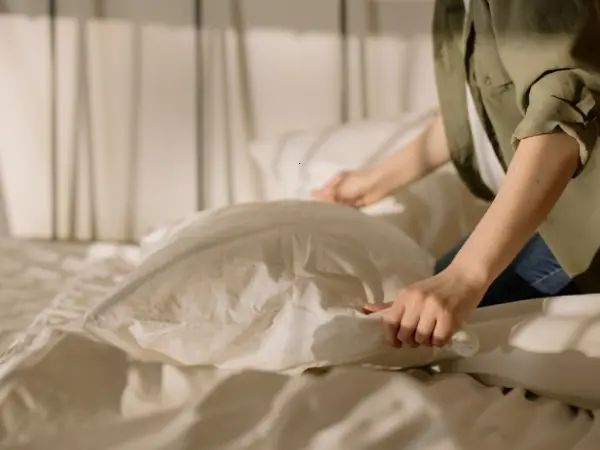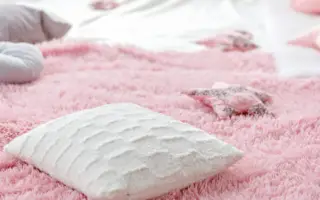Strep bacteria can survive on pillows and bedding for up to 3 days. Proper hygiene helps reduce the risk of infection.
Strep throat, caused by Streptococcus bacteria, is a common infection. Understanding how long these bacteria can survive on surfaces like pillows and bedding is crucial for preventing its spread. The bacteria can live on these surfaces for up to three days, posing a risk of reinfection or transmission.
What Is Strep Throat And How Is It Spread?
Understanding the nature of strep throat and its transmission is essential to prevent its spread and keep your home safe.
What Is Strep Throat?
Strep throat is an infection caused by the bacteria Streptococcus pyogenes, also known as group A streptococcus. It primarily affects the throat and tonsils, causing symptoms like sore throat, fever, and swollen lymph nodes. This infection is most common in children but can affect people of all ages.
How Is Strep Throat Spread?
Strep throat spreads through respiratory droplets released when an infected person coughs, sneezes, or talks. These droplets can land on surfaces, including pillows and bedding, where the bacteria can survive for a limited time.
There are several ways the bacteria can be transmitted:
- Direct contact: Touching an infected person or their belongings.
- Airborne transmission: Breathing in droplets from an infected person.
- Surface contamination: Touching surfaces with bacteria and then touching your face.
| Transmission Method | Description |
|---|---|
| Direct Contact | Touching an infected person or their belongings. |
| Airborne | Breathing in droplets from an infected person. |
| Surface Contamination | Touching surfaces with bacteria and then touching your face. |
To reduce the risk of infection, it is crucial to practice good hygiene. Wash your hands regularly, avoid close contact with infected individuals, and clean contaminated surfaces thoroughly.
Can Strep Bacteria Survive On Pillows?
One question people often have is: Can Strep Bacteria Survive on Pillows? This is a good question because we all use pillows every day.
Strep bacteria can live on pillows for a while. They don’t die right away. Scientists say the bacteria can stay alive on soft surfaces like pillows. This means if someone with strep throat used the pillow, it could still have bacteria on it.
How Long Can Strep Bacteria Live On Pillows?
Strep bacteria can live on pillows for a few hours up to a few days. The time depends on how warm and moist the pillow is. Warmer and wetter pillows help the bacteria live longer.
How To Clean Pillows With Strep Bacteria?
Cleaning pillows is important to kill the strep bacteria. Here are some steps to follow:
- Wash the pillowcase in hot water.
- Use a disinfectant detergent.
- Dry the pillowcase on high heat.
Signs Your Pillow Might Have Strep Bacteria
Noticing signs can help you act fast. Here are some signs:
- Someone with strep throat used the pillow.
- More than one person in the house has a sore throat.
- The pillow feels damp and warm.
How Long Does Strep Bacteria Live On Fabric?
Understanding how long strep bacteria live on fabric can help prevent the spread of this infection and ensure a healthier living environment.
Strep bacteria can survive on fabric for a significant amount of time. Studies suggest that strep bacteria can live on fabric for up to 24 hours. During this period, the bacteria can transfer to anyone who comes into contact with the contaminated fabric.
Factors Affecting Strep Bacteria Survival On Fabric
Several factors influence how long strep bacteria can survive on fabric:
- Type of fabric: Natural fibers like cotton may allow bacteria to survive longer compared to synthetic fibers.
- Humidity and temperature: Warmer and more humid environments can prolong the bacteria’s survival time.
- Exposure to sunlight: UV rays from the sun can kill strep bacteria more quickly.
Preventing Strep Bacteria Spread On Fabric
To reduce the risk of spreading strep bacteria through fabric:
- Wash bedding and pillows regularly: Use hot water and a disinfectant detergent to kill bacteria.
- Avoid sharing personal items: Do not share pillows, blankets, or towels with someone who has strep throat.
- Disinfect surfaces: Clean any surfaces that may have come into contact with the infected individual.
Signs Your Fabric May Be Contaminated
It can be challenging to determine if fabric is contaminated with strep bacteria, but some signs include:
- Recent contact with an infected person: If someone with strep throat used the bedding or pillow, they could have left bacteria behind.
- Presence of symptoms: If multiple people in the household develop strep throat, the fabric may be a source of contamination.

Factors That Affect Strep Survival On Bedding
This knowledge helps in maintaining a healthy environment and preventing the spread of infections. Several factors influence how long strep can last on these surfaces.
Temperature
Temperature plays a significant role in the survival of strep bacteria. Warm environments can promote bacterial growth, while cooler temperatures may slow it down. Keeping your bedroom well-ventilated can help reduce bacterial survival.
Humidity
Humidity levels also impact how long strep lasts. High humidity levels provide a conducive environment for bacterial survival. Low humidity can dry out the bacteria, reducing its lifespan. Using a dehumidifier can help maintain optimal humidity levels.
Material Of Bedding
The type of material your bedding is made from can influence bacterial survival. Natural fibers like cotton can absorb moisture, providing a breeding ground for bacteria. Synthetic fibers, on the other hand, may not retain moisture as much, potentially reducing bacterial survival.
Exposure To Sunlight
Sunlight exposure can kill bacteria on bedding. UV rays are effective in disinfecting surfaces. Regularly airing out your bedding in the sun can help reduce the presence of strep bacteria.
Cleaning Frequency
Frequent cleaning of your bedding can significantly reduce the survival of strep bacteria. Washing your sheets and pillowcases at least once a week is recommended. Using hot water and a good detergent can help eliminate bacteria effectively.
Presence Of Other Contaminants
Other contaminants on your bedding can affect how long strep lasts. Sweat, skin cells, and other organic matter can provide nutrients for bacteria, prolonging their survival. Keeping your bedding clean and changing it regularly can help mitigate this risk.
Immune System Interaction
Your immune system can also affect strep survival. Skin contact with infected bedding can transfer bacteria, possibly leading to infections. People with weakened immune systems are more susceptible. Ensuring cleanliness can help protect against infections.
Table Of Factors Affecting Strep Survival
| Factor | Impact on Strep Survival |
|---|---|
| Temperature | Warm temperatures increase survival; cool temperatures decrease it. |
| Humidity | High humidity increases survival; low humidity decreases it. |
| Material of Bedding | Natural fibers increase survival; synthetic fibers decrease it. |
| Sunlight Exposure | Reduces bacterial survival. |
| Cleaning Frequency | Frequent cleaning decreases survival. |
| Other Contaminants | Presence increases survival. |
| Immune System Interaction | Increases risk of infections. |
Cleaning And Disinfecting Pillows After Strep Exposure
Proper cleaning and disinfecting practices are essential to ensure a healthy environment.
How Long Does Strep Last On Pillows And Bedding?
Strep bacteria can survive on soft surfaces for up to 24 hours. It’s vital to clean and disinfect pillows and bedding promptly after exposure. This ensures that the bacteria do not spread or cause reinfection.
To effectively clean and disinfect pillows after strep exposure, follow these steps:
Step 1: Remove Pillowcases And Bedding
- Remove all pillowcases and bedding immediately after someone is diagnosed with strep throat.
- Place them in a laundry basket to avoid contaminating other surfaces.
Step 2: Wash In Hot Water
- Wash pillowcases and bedding in hot water. The water temperature should be at least 140°F (60°C).
- Use a high-quality detergent to ensure all bacteria are killed.
Step 3: Use A Disinfectant
- Add a disinfectant to the wash cycle. This could be bleach or a specialized laundry disinfectant.
- Follow the product instructions carefully to ensure effectiveness.
Step 4: Dry Thoroughly
- Dry the pillowcases and bedding on the highest heat setting.
- Ensure they are completely dry, as moisture can promote bacterial growth.
Step 5: Clean Pillows
- If the pillows are machine washable, wash them following the same steps as the pillowcases.
- If not, use a disinfectant spray suitable for fabric surfaces. Spray thoroughly and allow it to dry completely.
Additional Tips For Maintaining Clean Pillows
| Action | Frequency |
|---|---|
| Wash pillowcases and bedding | Weekly |
| Disinfect pillows | Monthly or after illness |
| Replace pillows | Every 1-2 years |
Following these steps ensures that your pillows and bedding remain free from strep bacteria. This keeps your environment healthy and reduces the risk of reinfection.
When To Replace Pillows After A Strep Infection
This guide will guide you on how long strep lasts on pillows and bedding and when it’s time to replace them.
After a strep infection, it’s essential to think about your pillows. Bacteria can cling to the fabric and linger, posing a risk for re-infection. But how do you know when to replace them?
Cleaning Vs. Replacing Pillows
Cleaning pillows might seem like a good option, but washing does not always eliminate all bacteria. High temperatures in washing and drying can help, but it’s not foolproof. If your pillow is old or has been heavily used during your illness, it’s better to replace it.
Signs Your Pillow Needs Replacement
- Visible stains or discoloration
- Unpleasant odors
- Loss of shape or support
- More than one year old
Steps To Take Post-infection
- Wash all bedding in hot water.
- Use a disinfectant on your mattress.
- Consider using pillow protectors in the future.
- Regularly clean your bedroom to prevent bacteria buildup.
Best Practices For Pillow Care
To keep your pillows fresh and bacteria-free, follow these tips:
| Action | Frequency |
|---|---|
| Washing pillowcases | Weekly |
| Washing pillows | Every 3-6 months |
| Replacing pillows | Every 1-2 years |
Regular maintenance and timely replacement of pillows can significantly reduce the risk of re-infection and improve your overall health.
How long does a strep test take at urgent care?
A strep test typically takes about 5 to 10 minutes for results at urgent care.
Duration of strep throat symptoms:
Strep throat symptoms usually last 3 to 7 days with treatment.
Lifespan of strep outside the body:
Strep bacteria can survive outside the body for about 3 to 4 days, depending on conditions.
Period during which strep bacteria survives on surfaces:
Strep bacteria can survive on surfaces for 24 to 48 hours under typical conditions.



